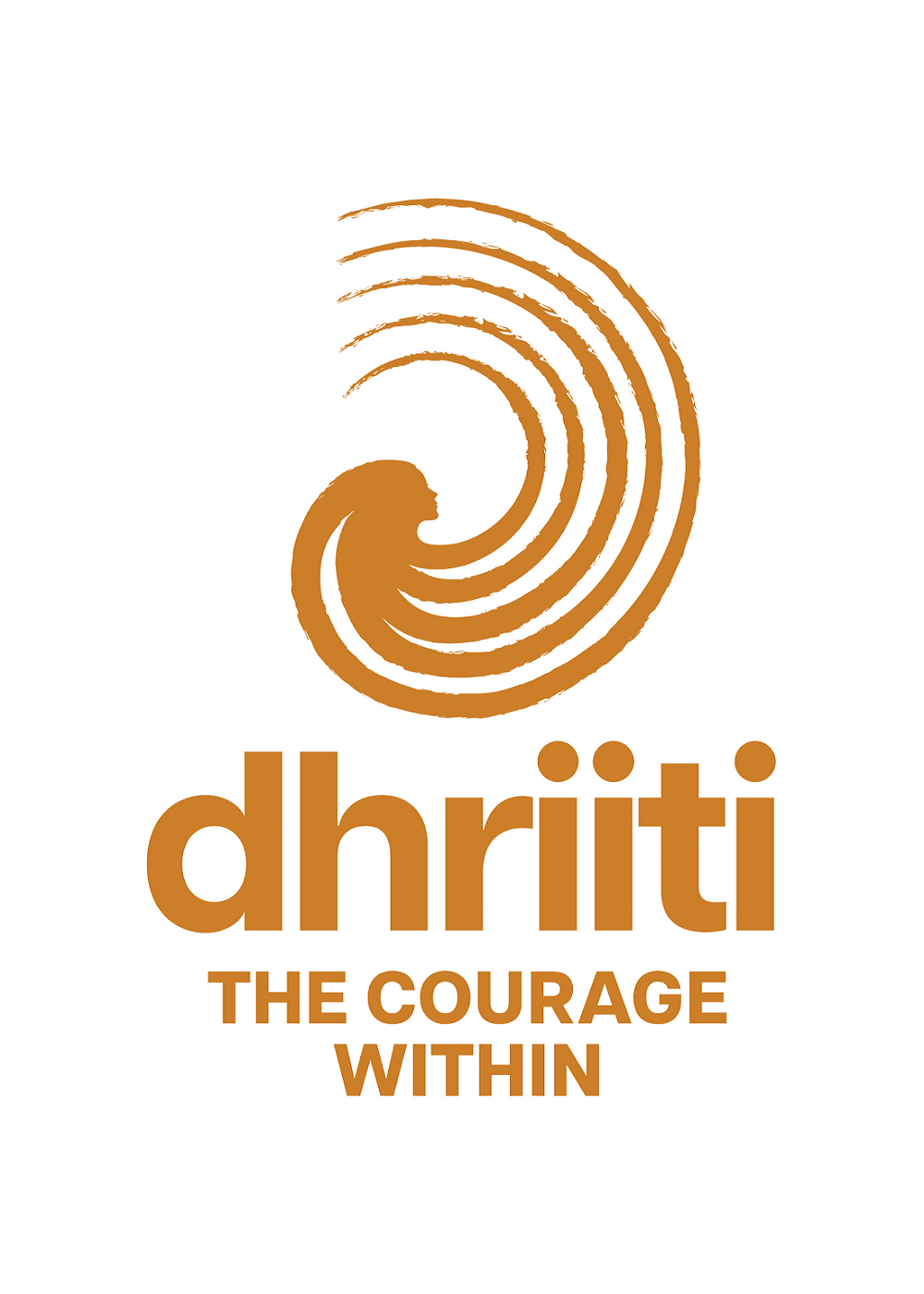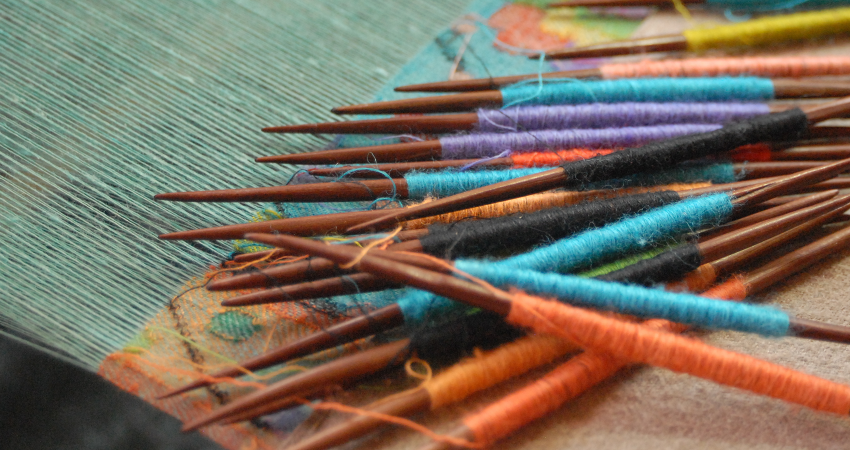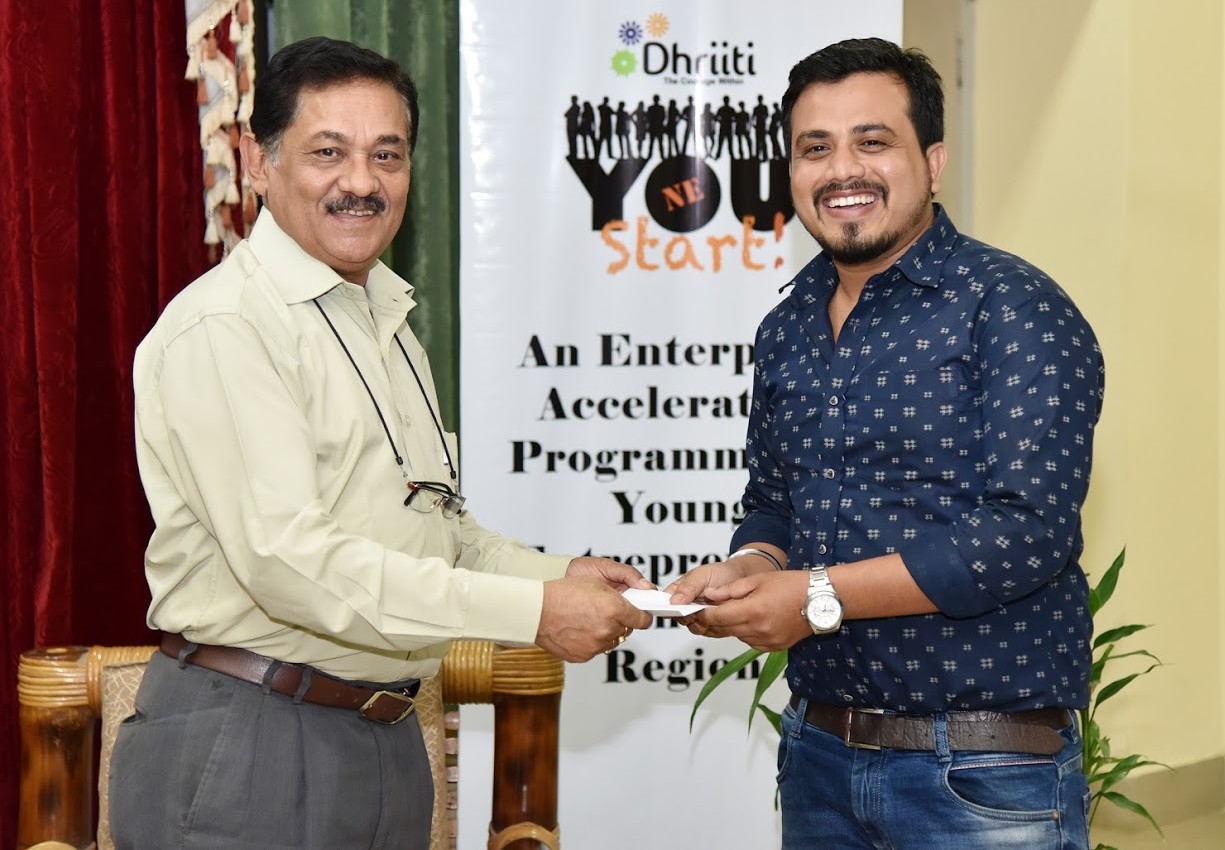
Dhriiti You Start! NE – Entrepreneur Awards 2018
YOU Start! NE – Enterprise Acceleration Programme for Youth Entrepreneurs – is an initiative dedicated to promoting youth entrepreneurship in North East India. After receiving approximately 100 application from states covering Assam, Meghalaya, Mizoram, Nagaland, Tripura and Manipur, we shortlisted and trained 52 young entrepreneurs from this region in 3 different cities i.e. Shillong, Guwahati and Dimapur. This was followed by mentoring support to each of the trained entrepreneur to enable them to develop robust enterprise plans, providing them with a solid foundation to sustain and grow their enterprises. 11 entrepreneurs were selected after the Ist round of Business Plan competition. This was followed by 12 weeks of mentoring support to accelerate their businesses. We are gearing up for the final event where 8 young entrepreneurs will be competing. The competition will be two segments one which is online voting and second is business pitches.
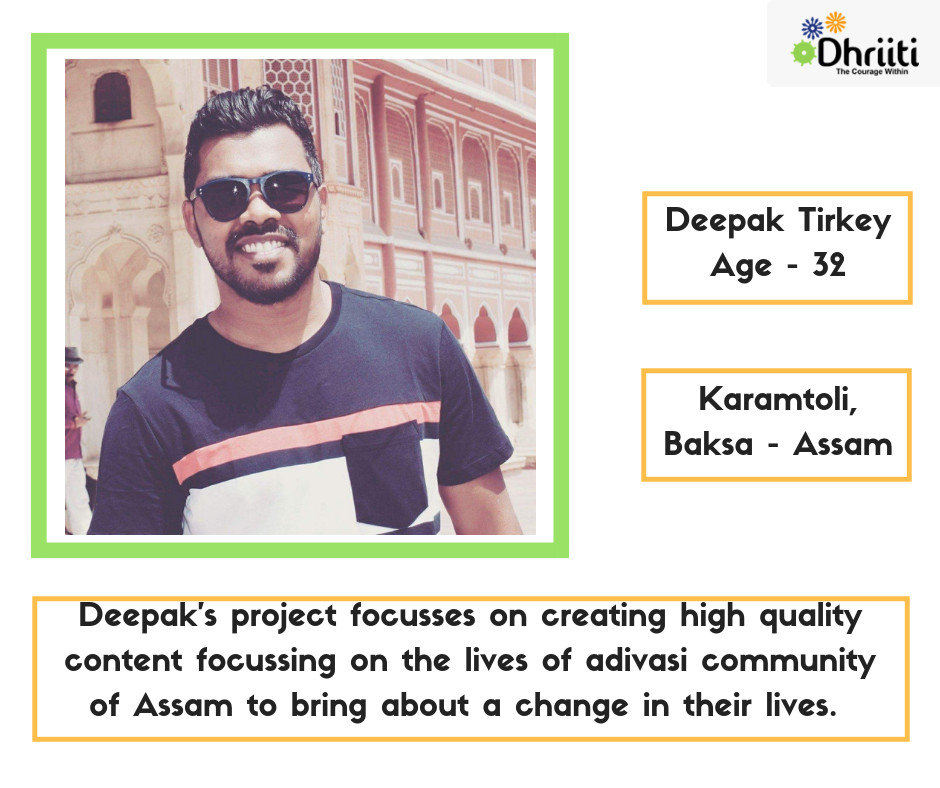 Deepak comes from the adivasi community of a small village of Baksa district of Assam. He completed his graduation from St. Anthony’s College, Shillong in Mass Communication and Video Production. He worked for 6 years in NDTV as an associate producer. But he longed to return back to his home and produced short films in Sadri language (native) portraying the stories of this region. In this process, he started his venture Westudios, an animation and video production company that aims to create quality content focusing on the Adivasi community of Assam. The basic idea is to create and produce audio-visual regional content in the realms of the performing arts, new media art, film, television, video, animation, design, etc.
Deepak comes from the adivasi community of a small village of Baksa district of Assam. He completed his graduation from St. Anthony’s College, Shillong in Mass Communication and Video Production. He worked for 6 years in NDTV as an associate producer. But he longed to return back to his home and produced short films in Sadri language (native) portraying the stories of this region. In this process, he started his venture Westudios, an animation and video production company that aims to create quality content focusing on the Adivasi community of Assam. The basic idea is to create and produce audio-visual regional content in the realms of the performing arts, new media art, film, television, video, animation, design, etc.
 Jenpu is from Dimapur, Nagaland. Growing up, Jenpu has witnessed many hardships, which led him to the idea of ‘CAN Youth’. He believes it is his social responsibility to work with the youth and children living with difficult circumstances. CAN Youth was established in 2012 with the sole aim to support the inopportune dropout youth and students from below poverty line (BPL) in Dimapur district of Nagaland. The organization is currently focusing on establishing Information and Resource Centre to provide services on education, skill, job opportunity, and entrepreneurship through various avenue and linkages for sustainability development.
Jenpu is from Dimapur, Nagaland. Growing up, Jenpu has witnessed many hardships, which led him to the idea of ‘CAN Youth’. He believes it is his social responsibility to work with the youth and children living with difficult circumstances. CAN Youth was established in 2012 with the sole aim to support the inopportune dropout youth and students from below poverty line (BPL) in Dimapur district of Nagaland. The organization is currently focusing on establishing Information and Resource Centre to provide services on education, skill, job opportunity, and entrepreneurship through various avenue and linkages for sustainability development.
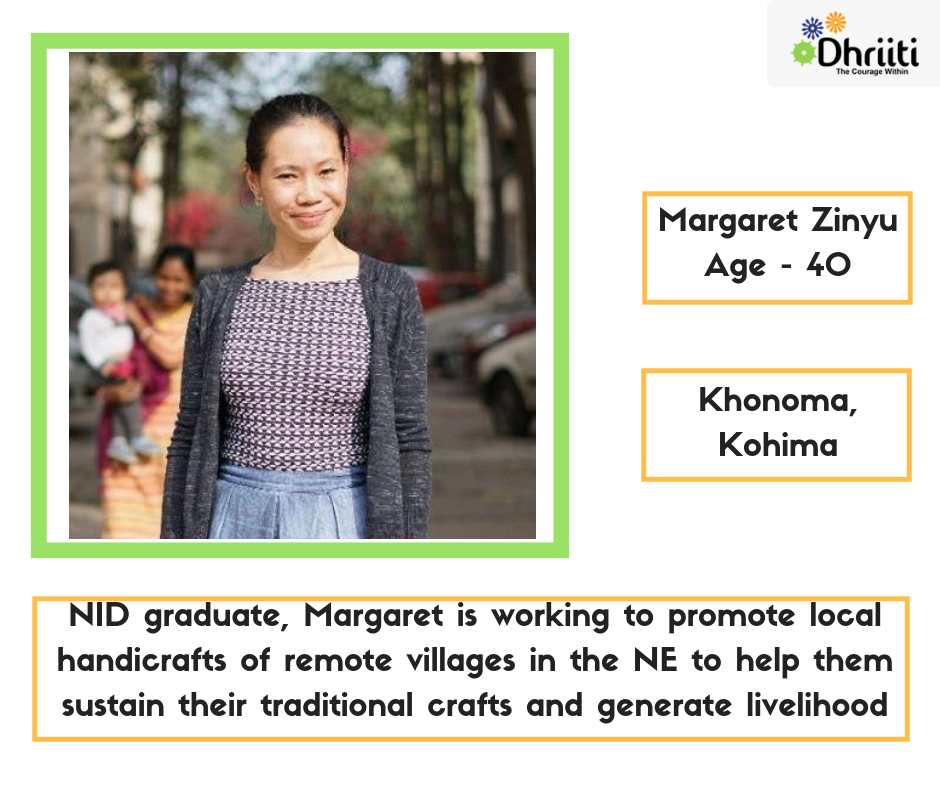 A NID Ahmedabad graduate, Margaret was always passionate about textiles. After working in the corporate sector of design for 8 years, she headed back home and decided to work in the craft industry. She set up Studio Predilection in 2015 with a belief that crafts is the second largest source of income for rural people in North East India and sustaining these skills as livelihood will create more employment generation. That way the indigenous traditions of Naga Crafts will also thrive for a better future. ‘Woven Threads’ is the label under Studio Predilection, which sells Handcrafted artisanal, contemporary, finesse, stylish and comfortable home furnishing products.
A NID Ahmedabad graduate, Margaret was always passionate about textiles. After working in the corporate sector of design for 8 years, she headed back home and decided to work in the craft industry. She set up Studio Predilection in 2015 with a belief that crafts is the second largest source of income for rural people in North East India and sustaining these skills as livelihood will create more employment generation. That way the indigenous traditions of Naga Crafts will also thrive for a better future. ‘Woven Threads’ is the label under Studio Predilection, which sells Handcrafted artisanal, contemporary, finesse, stylish and comfortable home furnishing products.
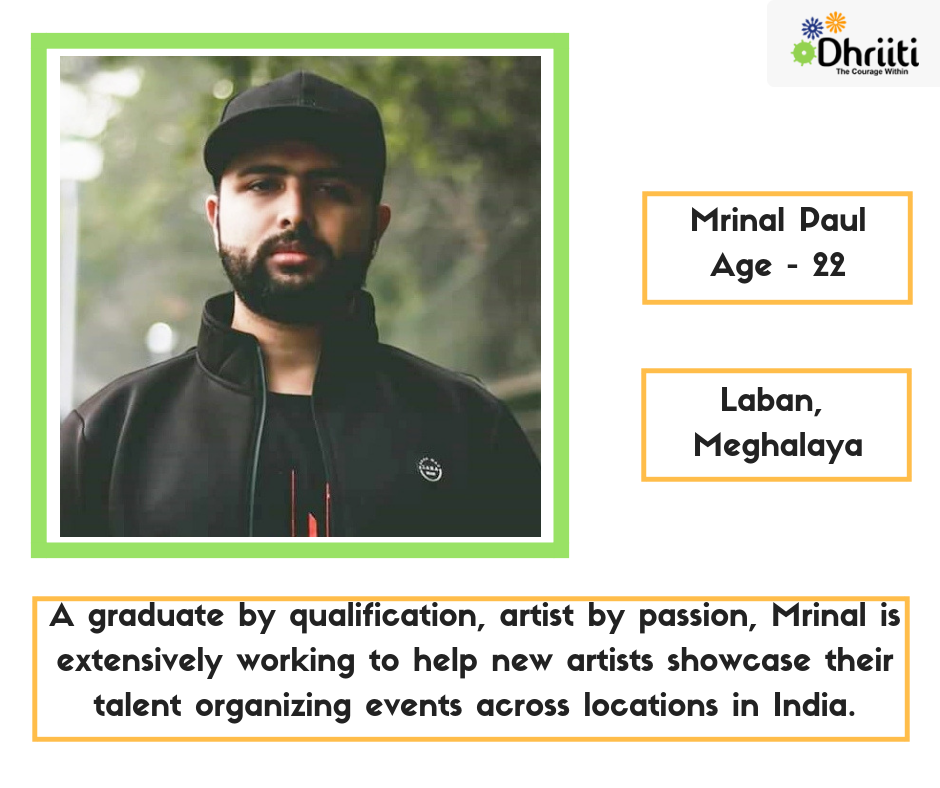 Mrinal, a graduate from Laban, Shillong, Meghalaya is an artist at heart and understands thoroughly the challenges that artists face. This led him to create an artists’ collective in 2016, which today has expanded into a talent and event management entity called MOX. The talent management agency is working with talents across the North Eastern region. MOX explores talents, builds their presence digitally, and curates LIVE opportunities for them to showcase their skills. The agency aims to showcase its artists across India and South-East Asia by next year.
Mrinal, a graduate from Laban, Shillong, Meghalaya is an artist at heart and understands thoroughly the challenges that artists face. This led him to create an artists’ collective in 2016, which today has expanded into a talent and event management entity called MOX. The talent management agency is working with talents across the North Eastern region. MOX explores talents, builds their presence digitally, and curates LIVE opportunities for them to showcase their skills. The agency aims to showcase its artists across India and South-East Asia by next year.
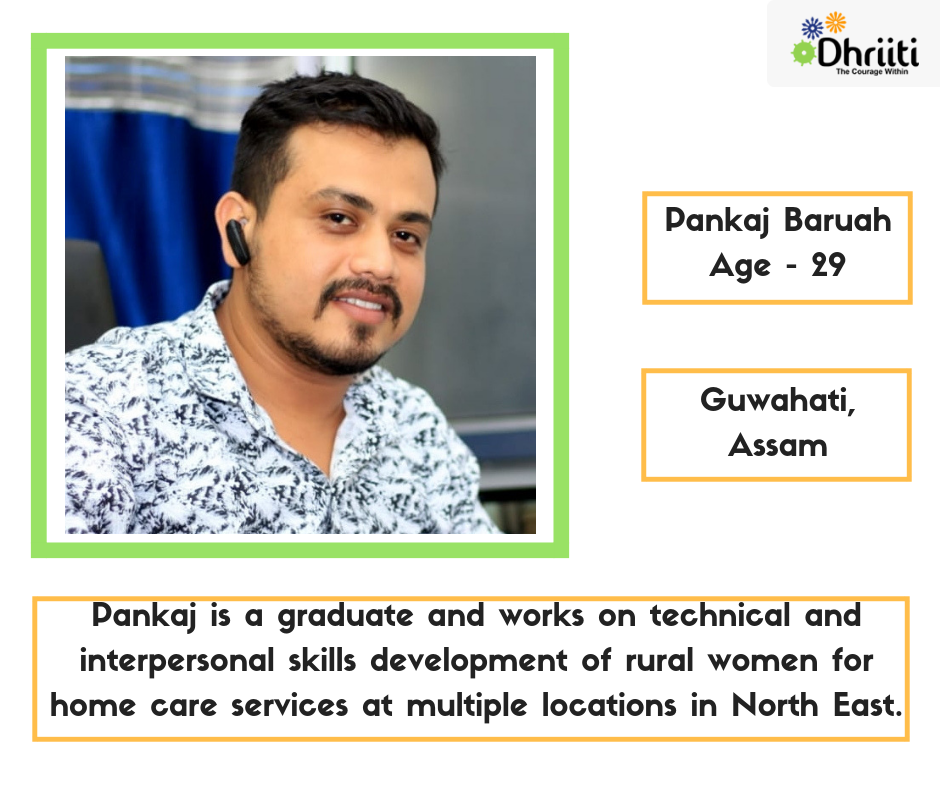 Pankaj is the Director of Maitri, a domestic service placement and management company which recruits, trains, and secures employment for women from underprivileged Northeast communities. “Sahayika” (caregiver in Hindi), the flagship program of Maitri is an initiative designed to build both the technical and interpersonal skills needed by domestic workers. The company also verifies that the prospective employer’s household does not have a history of issues with domestic service workers, sets clear expectations for the nature of work, and briefs the family on the prospective Sahayika’s background, skills, and employment preferences. Furthermore, Maitri takes this time to educate each Sahayika on her employee rights including a regular salary, paid leave, a bank account, and other benefits enjoyed by her service sector counterparts.
Pankaj is the Director of Maitri, a domestic service placement and management company which recruits, trains, and secures employment for women from underprivileged Northeast communities. “Sahayika” (caregiver in Hindi), the flagship program of Maitri is an initiative designed to build both the technical and interpersonal skills needed by domestic workers. The company also verifies that the prospective employer’s household does not have a history of issues with domestic service workers, sets clear expectations for the nature of work, and briefs the family on the prospective Sahayika’s background, skills, and employment preferences. Furthermore, Maitri takes this time to educate each Sahayika on her employee rights including a regular salary, paid leave, a bank account, and other benefits enjoyed by her service sector counterparts.
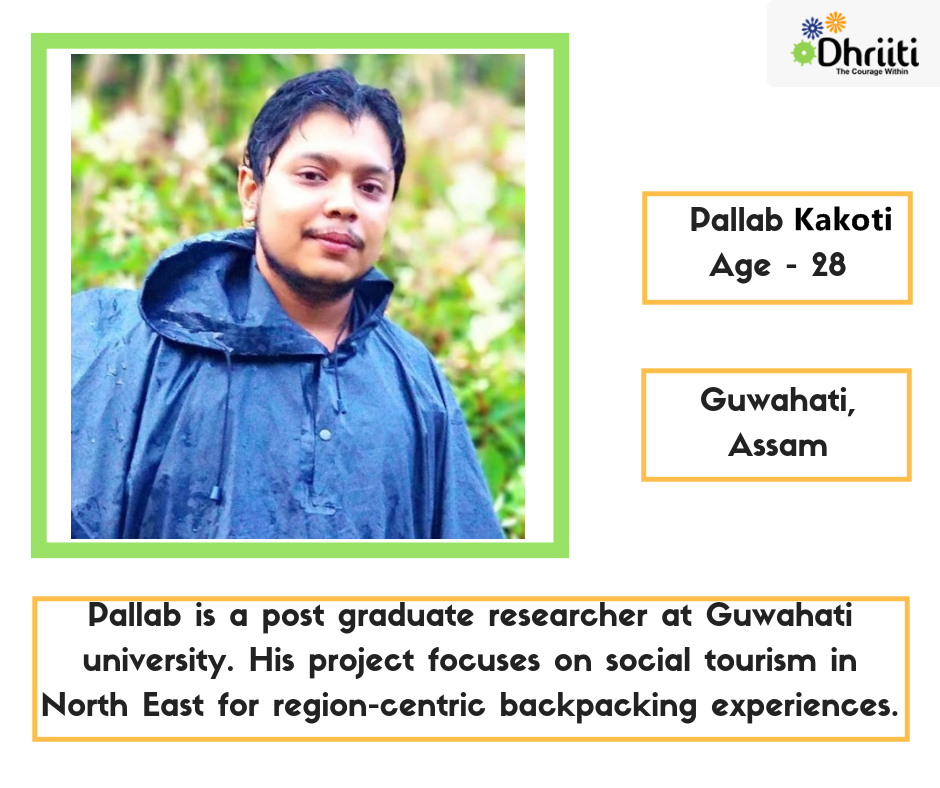 Pallab is a Post Graduate Researcher at Guwahati University. During the study of human capabilities, he realized that life is a constant pursuit of happiness. Some transcend to higher levels and associate their happiness with others. It was during a travel with his friends from abroad, who made him realize the potentiality of this region in terms of nature, resources available and the distinct yet varied culture. In 2017, he formed Eastern Wave, a community-powered tourism showcasing the culture and nature of Northeast India. Soon Pallab and his team started organizing camping trips and mainly catered to international backpackers as the company exactly offered the kind of experience these backpackers desire. Eastern Wave focusses on community-powered Tourism showcasing the Culture and Nature of Northeast India.
Pallab is a Post Graduate Researcher at Guwahati University. During the study of human capabilities, he realized that life is a constant pursuit of happiness. Some transcend to higher levels and associate their happiness with others. It was during a travel with his friends from abroad, who made him realize the potentiality of this region in terms of nature, resources available and the distinct yet varied culture. In 2017, he formed Eastern Wave, a community-powered tourism showcasing the culture and nature of Northeast India. Soon Pallab and his team started organizing camping trips and mainly catered to international backpackers as the company exactly offered the kind of experience these backpackers desire. Eastern Wave focusses on community-powered Tourism showcasing the Culture and Nature of Northeast India.
 An engineering graduate, Pratim has worked in the power industry for more than 7 years. He was actively associated with the technical and commercial aspects of the power industry. During his job stint, he realized the gap in the market and started working for the possible solutions to address those gaps. In 2016, he decided to become a full-fledged entrepreneur and founded Zinzid Technologies, which works with a vision to create technology solutions for sustainable development, primarily focusing on the energy efficiency of the customers and to reduce their environmental footprints. The company provides economic benefits to the customers, besides supporting the larger environmental goals.
An engineering graduate, Pratim has worked in the power industry for more than 7 years. He was actively associated with the technical and commercial aspects of the power industry. During his job stint, he realized the gap in the market and started working for the possible solutions to address those gaps. In 2016, he decided to become a full-fledged entrepreneur and founded Zinzid Technologies, which works with a vision to create technology solutions for sustainable development, primarily focusing on the energy efficiency of the customers and to reduce their environmental footprints. The company provides economic benefits to the customers, besides supporting the larger environmental goals.
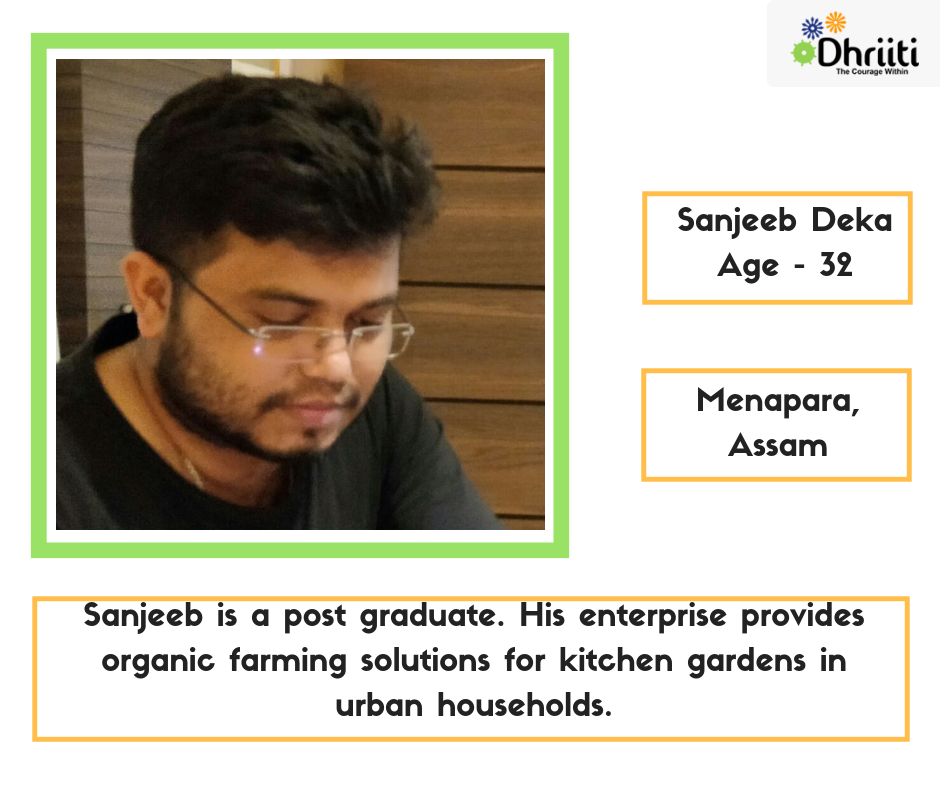 Sanjeeb comes from Menapara village of Daring district in Assam. After one of his family relatives achieved good health by using organic vegetables; he realized that organic vegetables have better nutritional value, improves health and also promoted to environmental sustainability. While working with Diya Foundation, Sanjeeb got an opportunity to practice organic farming in kitchen gardens in villages. He realized that urban households today are more inclined towards fresh organic fruits and vegetables. This idea gave birth to his venture, O-Kheti that presently sells a package of products and the services. The process is cost-effective and low-maintenance. Moreover one is aware that the best quality vegetables are being consumed by the family.
Sanjeeb comes from Menapara village of Daring district in Assam. After one of his family relatives achieved good health by using organic vegetables; he realized that organic vegetables have better nutritional value, improves health and also promoted to environmental sustainability. While working with Diya Foundation, Sanjeeb got an opportunity to practice organic farming in kitchen gardens in villages. He realized that urban households today are more inclined towards fresh organic fruits and vegetables. This idea gave birth to his venture, O-Kheti that presently sells a package of products and the services. The process is cost-effective and low-maintenance. Moreover one is aware that the best quality vegetables are being consumed by the family.

Plastic ban: An opportunity to encourage ecological and economic growth
The need of eco-friendly products has never been so important than today when plastic has already choked our cities, oceans, and mountains. This year on World Environment Day, the entire world took a pledge to ‘Beat Plastic Pollution’ to combat one of the great environmental challenges that our generation is facing. Continuing the resolution, Maharashtra, and Uttar Pradesh states banned the use of plastics in July while Odisha government has planned to implement the rule from October month. This comprehensive plastic ban also includes disposable cups and plates, cutlery, and packaging. Hence, the products made of natural resources like leaf, coconut, and wood have caught the attention of everyone these days.
Plastic waste has become a major concern in urban areas and people now are looking for options to replace the plastic cutlery with recyclable products. This rising demand of eco-friendly products has created entrepreneurship opportunities for people in rural and semi-urban areas. To boost small enterprises, many corporates and NGOs are also providing technology and skill development programs that help people in their entrepreneurial journey and build a community of rural entrepreneurs. New Delhi based NGO, ‘Dhriiti – The Courage Within’ is working towards its mission of transforming communities by developing entrepreneurial skills in people from diverse socio economic backgrounds.
Dhriiti works with entrepreneurs who identify and convert opportunity into sustainable enterprises to enhance the quality of livelihood. The organization nurtures, incubates, and support potential entrepreneurs through its innovative and professional approach. It endeavors to promote entrepreneurship in different forms and build a spirit of entrepreneurship amongst the communities. With its ‘Financial, Social, Ecological (FSE)’ concept, Dhriiti works with aspiring entrepreneurs who can build transformative enterprises to protect the environment and bring a positive change in the society.
The organization understands that rural areas have great potential but people face challenges like limited access to finance, gaps in skills, unfavorable business environment; low financial sustainability, and lack of planning. Dhriiti team aims to meet such challenges and promote small industries by applying modern management and technology tools. The organization is running various skill development and entrepreneurship projects with support from corporates and state governments. As a part of its endeavor for North East India, it has been working on ‘Arecanut Leaf Plate Manufacturing Cluster Development Project’ in Assam.
More than 500 micro enterprise units have been set up under this project to make disposable plates and bowls from the sheath of arecanut trees. Till date, the project has trained more than 5000 people and has engaged 7000 families in North East India. The enterprise has created a positive impact on region’s employability percentage as each unit provides employment to more than 20 rural youths. ‘Tamul Plate Marketing Pvt. Ltd. (TPMPL)’, an institution created under this initiative manages the whole operations in a commercially sustainable manner.
Today, TPMPL markets the high quality products at national and international level under the brand name, Arecana. The project has been the most successful program wherein Dhriiti nurtured the entire project for 10 years and handed over operations to the producers’ institution. Going forward, the program has a vision to build a micro enterprise value chain worth INR 100 crores in North East by 2020.
Additionally, to further push the growth of eco-friendly industries, Dhriiti is working on its ‘Sal and Siali Leaf Plate Cluster Development’ project supported by Odisha Forestry Sector Development Project (OFSDP), Government of Odisha. The project is aimed towards the development of innovative product designs for high end urban areas as well as the international market. The project aims to become a people’s institution in next five years boosting the Sal and Siali leaf plate manufacturing in the state. Dhriiti team will be working with Sal leaf plate producers in two blocks of Keonjhar and Rourkela. The project will be amplified further as a full cluster development program in partnership with various public and private bodies.
Needless to say that making eco-friendly product from leaf and other natural sources not only supports the underprivileged community but also helps in saving environment and reducing wastage. As the plastic is badly affecting our health and surroundings, the use of eco-friendly products has become more like a necessity than a choice. By adopting sustainable habits and promoting eco-entrepreneurship, we can surely give a gift of health and happiness to our next generation.

What are the steps involved and the costs to register a trademark in India?
The official fee charged by the Indian trademark office is Rs.4500 (Individuals, Startups and Small and Medium Enterprises – SME’s) and Rs.9000 (for others) per mark per class. The professional charges start from Rs.1999 and upwards depending on your service provider. It is as simple as deciding to have pani poori from your street corner vendor or having it at a five-star hotel. What’s important to be considered in choosing your service provider [as with any service] is the experience and quality of service one offers.
Your brand is the most valuable asset of your business and you should take some time to choose the right service provider. You can ask your service provider to provide you with a list of trademark they have helped register. Trademark records and their details are made available to the public and your service provider should be able to provide you this without any hassles. You can then cross check a few application numbers at the Indian trademark office website by keying in the application numbers.
Another major issue faced by trademark owners in India is that every tom dick and harry offers trademark filing. Yes, they offer filing, not registration. While I appreciate the fact that several designers, domain name registrants, accountants, engineers, and CA’s offer this as an extended service to their clients, it is unfortunate that quite a few of these service providers learn trademark law at the cost of their clients. It is also important to understand that obtaining a registration for a trademark in India involves several steps and it is not merely a form filling job. You should ask your service provider to provide you with the other costs, if any, from filing to registration. In many cases the trademark owner is in for a surprise with additional costs at a later date when objections are raised by the trademark office or oppositions are filed by third parties.
Let’s understand the steps involved in getting your trademark registered in India.
- Selecting a mark
- Classification of goods or services
- Search the trademark office records
- Filing the application
- Responding to objections from the trademark office
- Advertisement in the trademark journal
- Handling opposition by third parties
- Registration
- Maintenance or Renewal
Selecting a trademark is one of the toughest job for the trademark owner. This is going to be your brand and changing it later is not going to be easy. After several brainstorming sessions, you choose the right brand name for your business. Now that you have come up with a brand name it’s important to do a trademark search.
Classification of goods of services is very important for you to protect your trademark for the right goods of services you offer under your trademark. It is important that your service provider understands your business well before deciding to select the classes in which the trademark should be protected. For example, your trademark will fall under difference classes if you offer web app development services vs having an app for the purposes of selling goods online.
Trademark Search is the process where the records of the trademark office are searched for the same or similar marks in the classes of your choice to see if anyone has filed for similar marks earlier than you. Additionally, it is advisable to do a general Internet search as well. Several countries including India are not a first to file but rather a first to use country. This means that whoever uses the trademark first gets more rights than the one who filed for an application with the Indian trademark office.
Thought trademark rights are territorial, technology has made the world a small place. Hence, it is advisable to run a Global search in whichever jurisdictions possible. Several trademark office databases are available online with free access.
A good thumb rule we follow at our firm is to check if a .com domain name is available for your trademark. If it’s not available, then it’s a red flag that needs to be considered. Many times, the domain names are merely parked and not used.
Costs for a trademark search: [Professional fees range from Rs.500 to 2500 per trademark per class along with a professional opinion+ No official fees.]
Filing the application may be one of the easiest one once the above steps are done properly. It’s like as getting your foundation in place before you start building your house. However, it is important to put in the right information in your application to avoid any objections by the trademark office on a later date. This obviously comes with experience.
[Professional fees range from Rs.999 and upwards per trademark per class + Rs.4500/9000 as official fees per mark per class.] Timeline: 1 to 2 days.Objections are raised by the trademark office when they examine your application to register your trademark and the same should be responded to and complied within one month from the date of such objections. Most of these objections can be avoided when the same is foreseen at the time of classification and trademark search by your service provider. This not only saves costs but a lot of time in the process of getting your trademark registered in India.
[Professional fees ranges from Rs.1499 and upwards per trademark per class. No Official fees] Timeline: 1 to 2 months from the date of filing your application.Advertisement of the application in the journal is because any third party can oppose to the registration of your mark on several grounds. The most common one being that your mark is like their mark. Opposition proceedings are long and costly and could be avoided by following the right strategy before filing the application. Timeline: 4 months from the date of advertising the application.
Registration is granted in the absence of any opposition within 4 months from the date of advertisement. The registration is valid for a period of 10 years from the date of the application. You should start using the ® symbol on your trademark immediately. Timeline: A week after expiry of the opposition period and in
the absence of any opposition.
Renewal of a trademark in India can be filed six months prior to its expiry date. The renewal grants another 10 year protection to your rights on your trademarks. [Professional fees range from Rs.1999 and upwards per trademark per class + Rs.9000/class as official fees per mark per class.]
Your brand is your most prized asset and trademark rights are perpetual. It should be carefully coined, protected, and maintained. When you decide to file for an application to register your trademark keep these in mind in choosing your service provider.
If you have something to add to this article or comment on the same feel free to comment below or reach out to me by email.
Original content of the above blog can be read at: https://selvams.com/blog/steps-involved-costs-register-trademark-india/

Trade Marks Rules, 2017 – What it means for Startups & SME’s
The Controller of Patents, Designs and Trademarks through a public notice dated November 19, 2015 brought to the notice of the public the draft of the Trademarks Amendment Rules, 2015 proposing to amend the Trademark Rules, 2002 and had invited comments from the public and stakeholders within 30 days from the date the notification published in the official gazette of India. At last, the Trademarks Rules, 2017 came into effect on March 06, 2017 with several changes ranging from increase in official fees, discount for online filing of trademark applications, hearing through video conferencing, maintaining a list for well-known trademarks among other things.
While this post will cover only the amendments with respect to startups and small enterprises (SME’s) you may also check out posts from my colleagues in respect of the journey of the trademark office from paper filing to digital, practical aspects of the online trademark filing system, increase in the official fees to an extent of 125% and changes in the rules in general and the reduction of the number of the trademark forms.
The new rules offer 50% discount on the official fees for startups and SME’s (small and medium enterprises) with respect to filing an application for registration of a trademark and for expedited processing of an application for registration of a trademark. Filing an application for registration of a trademark is Rs. 5000 (Paper Filing) / Rs. 4500 (e-filing and expedited processing of an application for registration of a trademark is Rs. 20000 (e-filing only)
The applicant should be recognized as a startup by the competent authority under the Startup India initiative. To qualify as a small enterprise, the applicant’s investment in plants and machinery alone should not exceed ten crore rupees if the applicant is a manufacturer. However, if the applicant is a service provider, the investment in equipment in general should not exceed five crore rupees.
Unlike the Indian Patent Amendment Rules, 2016 where the applicant being a startup/individual/SME enjoys discounted costs for the entire life of a patent application and even subsequently thereafter, in respect of renewal of the patent, the Trademark Rules, 2017 has limited the discounts with regard to Startups/Individuals/SME’s only filing and expedited examination of the trademark application.
The other amendment that startups might find useful is the ability to request amendment of the specification of goods and services in the event of them being wrongly classified at the time of filing the application. On several occasions, entrepreneurs and applicants file applications on their own or using a low-cost filing service provider which may not have an experienced lawyer to classify the specifications of goods and services. When the trademark office raises objections on erroneous classification, the only option earlier was to file a fresh application or delete the specifications objected by the examiner. However, the amendment now provides for splitting the classification and adding new classes to the present application. This will save the applicant from losing time and priority by filing a new trademark application.
Original content of the above blog can be read at: https://selvams.com/blog/trade-marks-rules-2017-means-startups-smes/

New initiatives from the copyright office for registration of copyrights in India
Digital technology is drastically changing our ways of life, whether it’s home or office and the Copyright office is no exception to it. In its attempt to use the technology and to enhance transparency in Copyright prosecution in India, the Copyright Office recently issued a Public Notice wherein stating that the Copyright Office going forward shall publish on its website a list of all applications received by it for copyright registration. The said list shall be published on the first Friday of every month.
Recently, the Government of India has shifted the Copyright Office under the control of the Department of Industrial Policy & Promotion (DIPP) which operates under the Ministry of Industry and Commerce. Now, DIPP has control over Copyright Office in addition to the Patents, Designs, and Trade Marks Offices. Over the years, the Trade Marks and Patents Offices have been publishing the accepted applications in weekly Journals respectively and on similar lines, the Copyright Office has now initiated the monthly publication of copyright applications.
Under Indian Law, copyright comes into existence the moment a work is created. However, the copyright registration provides you with the statutory right to have the work protected under law and it constitutes prima facie evidence in case of a copyright infringement. In order to have a copyright registered, the Applicant has to follow the procedure laid down in the Copyright Act and Rules thereunder.
As per Rule 70 (9) of the Copyright Rules 2013, the person applying for registration of a copyright shall give notice of his application to every person who claims or has any interest in the subject matter of the copyright or disputes the rights of the applicant.
In lieu of the said provision, this publication of a list of applications by the Copyright Office would be treated as a notice. Post-publication, the copyright applications shall be open to objections from third parties for a period of thirty (30) days from the date of availability of the said list to the public and in the absence of any such objection being raised within the prescribed time, the copyright applications shall proceed towards examination.
However, in the event an objection is raised by the third party, the Applicant would be required to submit the corresponding documents/response with respect to his copyright application, failing which the application will be treated as abandoned.
This initiative regarding the publication of copyright applications is a significant step forward towards bringing in, the digital technology in intellectual property registrations. The Copyright Office has taken the attempt in order to ease the procedure of Copyright registration in India and consequently, it also paved way for speedier disposal of the applications. The innovative approach of following the procedure of giving notice under the said rule would definitely give relief to the Applicants of Copyright registration.
Original content of the above blog can be read at: https://selvams.com/blog/new-initiatives-copyright-office-registration-copyrights-india/

Why Startups need to protect their Intellectual Property before disclosing it
Intellectual Property – Creations of your Mind
‘A hundred and one wonders our mind holds,
And out of it rarely a creation unfolds!’
Isn’t that true? Imagine you have created something ingenious, what we formally call “Intellectual Property” or simply IP, like a truly mind-blowing technology/invention or an original design or a very simple yet original poem like the one above. So what would your next step be? Simply cherish the IP and give it all up for the others to use (the right word here is “misuse”) or protect the IP in the way it should be?
Start-Ups and IP
Of course, the above scenario holds good for any person; but it is all the more important if you are a Start-up, fresh into an industry, trying to make your efforts count, especially where your business involves dealing with IP. Moreover, as a Start-up, you may have the zeal for business, yet being new, you may not possess a clear idea about the implications your Intellectual Property might have on your business.
Why Protect IP
You may naturally have second thoughts about protecting your Intellectual Property and several questions may arise, such as-
- Is the IP valuable enough to be protected?
- Why take/waste the efforts and resource to protect the IP?
- What if I stay put and simply enjoy the IP?
All the aforementioned questions are answered below.
Is the IP valuable enough to be protected?
A Start-up’s IP may be anything ranging from a newly invented know-how/invention that is banked upon to run the very business or simply the brand which would be the identity of the Start-up or some creative content like literary, dramatic, cinematography, artistic or sound recording work. These are only a few broad examples. In all the cases, your Start-up would revolve around your IP in one way or the other and managing and protecting the same might actually decide the ground for you.
Why take/waste the efforts and resource to protect the IP? What if I stay put and simply enjoy the IP?
Let’s take an interesting example – Imagine you have invented the transportation machine by which you can get transported from one place to another within moments (a.k.a Harry Potter style). Obviously, you would intend to cash in on the said technology/machine and you decide to enter into a Joint venture with another entity and disclose all the details relating to your machine/technology in good faith without any reservation.
One fine day, you find that the other entity no longer needs you in the Project and surprise of all surprises, that entity is already underway to use the technology, claiming ownership for the same. Of course you can fight this out legally, which would take years altogether, by which time your Start-up would, in all probability, have turned to dust.
Another example – You have created a brand/mark for a product and your whole business revolves around it. But getting trademark registration for the mark/brand just slipped your mind and then out of the blue, you come across another mark which has an uncanny resemblance to your own brand. With no trademark registration backing for the mark, you will have to battle with the other party to prove that you are a bonafide owner of the mark and that you are genuinely using it prior to the other person.
Another scenario is where you author a book or create a design and in each case, protection of the IP becomes crucial. Else it is better to be prepared for third parties to hijack your IP and more importantly, the financial openings that your IP would have laid at your doorstep.
The Reasons in a Nutshell
1) Your IP is your brainchild and for this sole reason, it deserves protection.
2) Your very idea of initiating a business/Start-up might have sprung from your IP or in due course, your Start-Up might come to bank upon an invention or a trademark or other original, creative content. So even to get the Start-up thriving and running, protecting your IP is imperative.
2b) As a joinder to the above, your IP might be capable of financially feeding you and your Start-up like royalty for invention licensed to a third party or a franchise and continued protection of the IP is what ensures that the financial inflow does not cease.
3) Where you disclose your IP to third parties without protecting it first, you would only engage in legal battles to prove your ownership to the IP, which is not only time-consuming but will end up swallowing your very Start-up with the financial burden, not to mention the mental agony it brings with it.
Hence it would be prudent to take the effort and protect your IP as soon as creating it rather than disclose and take desperate efforts to hold on to it later.
There is no end to IP protection
Be it a Patent, Trademark, Copyright, Design or other forms of IP, the protection process does not end as soon as you register the IP. IP protection is a continuous process. For one, renewal of your IP (where applicable) as and when it arises, is a must do. Comprehensive information on renewal of trademarks by my colleagues could be found here.
Once you have an official entitlement to your IP, the next step is to stay vigilant to ensure that no person attempts to hijack/infringe it, let’s say by using similar technology/deceptively similar mark/similar piece of work. This is in most cases, entrusted to IP counsels who would have a better idea as to what might pose a threat to your IP. In this situation, you have a better edge since you will not have the necessity to prove your title, which is the most important point to be established.
Driving home the point, in respect of trademarks, where a person has a registration for a mark and a third party has a mark deceptively similar; a suit for infringement (more about infringement could be found here) can be filed and in such a suit, only the deceptively similarity is required to be proven. On the other hand, where the mark is not registered, a passing off action can only be initiated, in which case, not only deceptive similarity, but likelihood of deception/confusion is also required to be proved. This of course is certainly not an easy task.
IP for Inviting Problem or Invaluable Protection
The above would certainly give a fair idea as to why it is imperative to protect IP before disclosure to any person. And there are various ways to protect your IP which would, inter alia, depend upon the nature of IP and other surrounding factors. You could always write to us to know ways to protect your IP. You could either protect it or wait for others to protect it..in their name of course.
Original content of the above blog can be read at: https://selvams.com/blog/startups-need-protect-ip-disclosing/
